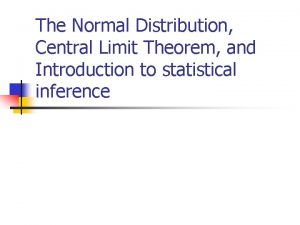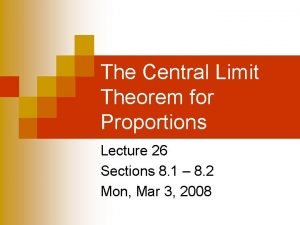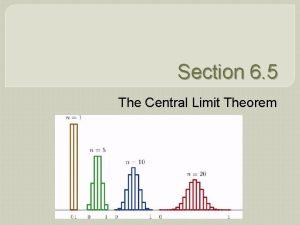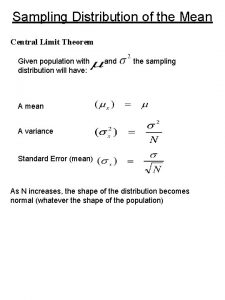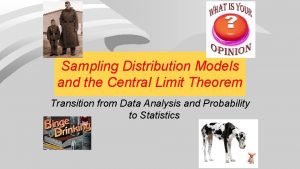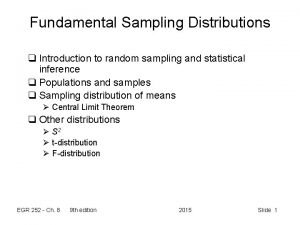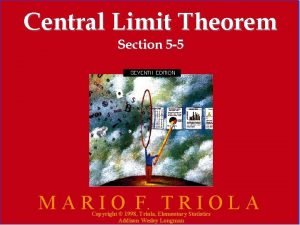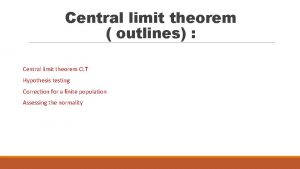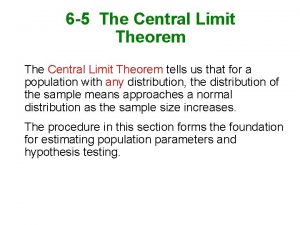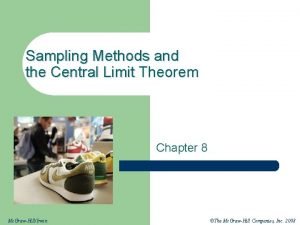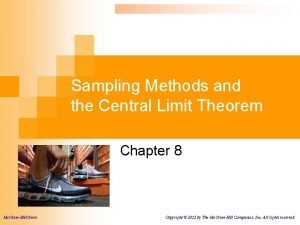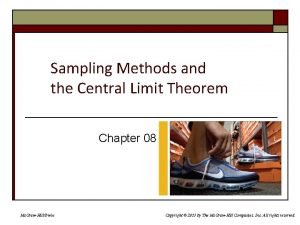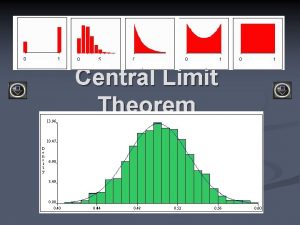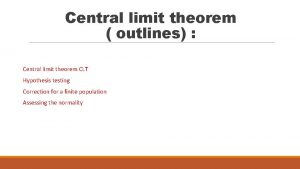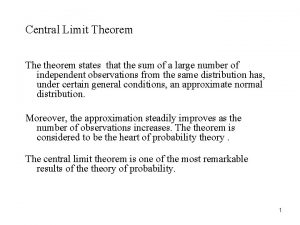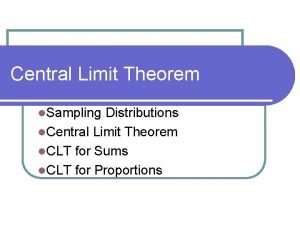Ch 7 Central Limit Theorem Use the Central












- Slides: 12

Ch 7 Central Limit Theorem • Use the Central Limit Theorem to solve problems for large samples.

6. 3 The Central Limit Theorem In addition to knowing how individual data values vary about the mean for a population, statisticians are interested in knowing how the means of samples of the same size taken from the same population vary about the population mean. The central limit theorem tells us that if a sample size is large enough, the distribution of the sample means can be approximated with a normal distribution even if the original population is not normally distributed.

Distribution of Sample Means • A sampling distribution of sample means is a distribution obtained by using the means computed from random samples of a specific size taken from a population. The mean of the sample means will be the same as the population mean. • Sampling error is the difference between the sample measure and the corresponding population measure due to the fact that the sample is not a perfect representation of the population. • Because of the sampling error, the standard deviation of the sample means will be smaller than the standard deviation of the population, and will be equal to the population standard deviation divided by the square root of the sample size. This is known as standard error of the mean

The Central Limit Theorem • As the sample size n increases, the shape of the distribution of the sample means taken with replacement from a population with mean and standard deviation will approach a normal distribution. • The standard deviation of the sample means is called the standard error of the mean

The Central Limit Theorem • The central limit theorem can be used to answer questions about sample means in the same manner that the normal distribution can be used to answer questions about individual values. • A new formula must be used for the z values:

Example: Hours of Television A. C. Neilsen reported that children between the ages of 2 and 5 watch an average of 25 hours of television per week. Assume the variable is normally distributed and the standard deviation is 3 hours. If 20 children between the ages of 2 and 5 are randomly selected, find the probability that the mean of the number of hours they watch television will be greater than 26. 3 hours.

Example: Hours of Television Since we are calculating probability for a sample mean, we need the Central Limit Theorem formula for a z-score The area to the right of z = 1. 94 is 0. 0262. The probability of obtaining a sample mean larger than 26. 3 hours is 2. 62%.

Example: Vehicle Age The average of a vehicle registered in the United States is 8 years, or 96 months. Assume the standard deviation is 16 months. If a random sample of 36 vehicles is selected, find the probability that the mean of their age is between 90 and 100 months. Since the sample is 30 or larger, the normality assumption is not necessary.

Example: Vehicle Age The desired area between z = -2. 25 and z = 1. 50 is 0. 9210. The probability of obtaining a sample mean between 90 and 100 months is 92. 1%.

Example: Meat Consumption part A The average number of pounds of meat that a person consumes per year is 218. 4 pounds. Assume that the standard deviation is 25 pounds and the distribution is approximately normal. a. Find the probability that a person selected at random consumes less than 224 pounds per year. Because we are not trying to find the probability that the sample mean falls at a certain location on the curve **we will use the regular population z-score calculation The area to the left of z = 0. 22 is 0. 5871. Hence, the probability of selecting an individual who consumes less than 224 pounds of meat per year is 0. 5871, or 58. 71%.

Example: Meat Consumption part B The average number of pounds of meat that a person consumes per year is 218. 4 pounds. Assume that the standard deviation is 25 pounds and the distribution is approximately normal. b. If a sample of 40 individuals is selected, find the probability the sample mean will be less than 224 pounds per year. Because we are trying to find the probability that the sample mean falls at a certain location on the curve ** we will use the Central Limit Theorem z-score calculation The area to the left of z = 1. 42 is 0. 9222. Hence, the probability that the mean of a sample of 40 individuals is less than 224 pounds per year is 0. 9222, or 92. 22%.

Discuss with your elbow partner: 1) How are these calculations are different? 2) Why is there a difference in the final solutions?
 Define null hypothesis
Define null hypothesis Central limit theorem for proportions
Central limit theorem for proportions Rules of central limit theorem
Rules of central limit theorem Central limit theorem variance
Central limit theorem variance Central limit theorem
Central limit theorem Onlinestatbook central limit theorem
Onlinestatbook central limit theorem Central limit theorem formula
Central limit theorem formula Rules of central limit theorem
Rules of central limit theorem Clt formula
Clt formula Central limit theorem
Central limit theorem Sampling methods and the central limit theorem
Sampling methods and the central limit theorem Sampling methods and the central limit theorem
Sampling methods and the central limit theorem Sampling methods and the central limit theorem
Sampling methods and the central limit theorem
